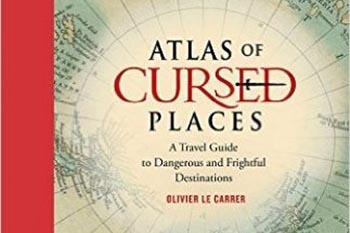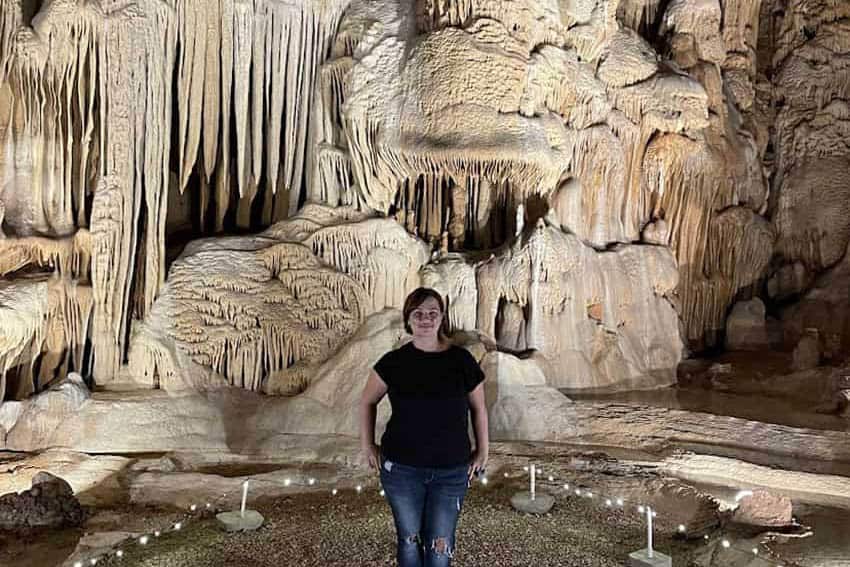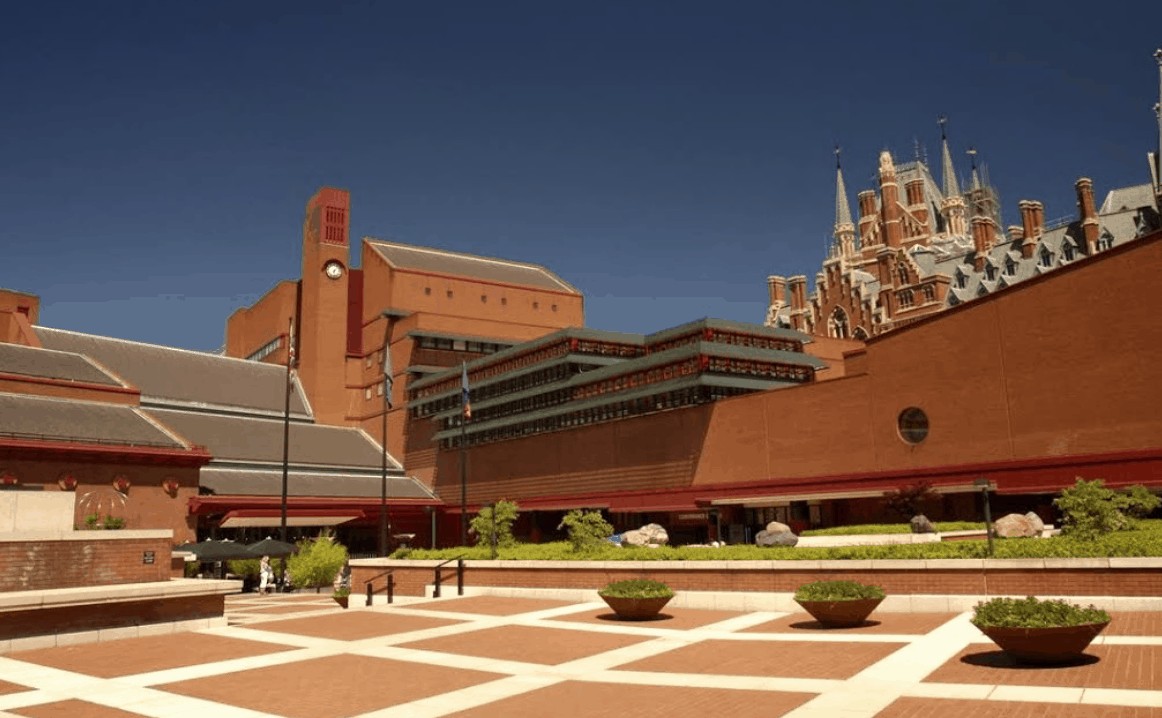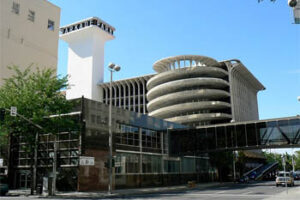An excerpt from the Book of Unforgettable Journeys by Russell Banks
By Jon Brandt
 A new collection of travel stories was released in September by Penguin Books, entitled The Condé Nast Traveler Book of Unforgettable Journeys. This book features 21 different stories about locations throughout the world, as well as updated information about the locations.
A new collection of travel stories was released in September by Penguin Books, entitled The Condé Nast Traveler Book of Unforgettable Journeys. This book features 21 different stories about locations throughout the world, as well as updated information about the locations.
All of these stories are great and worth checking out, but one in particular that sticks out is “Primal Dreams” by Russell Banks. Banks paints an eloquent portrait of his love for the Florida Everglades, and shows how one man can get lost in a different world, seemingly thousands of years in the past, while only miles from civilization.
“Primal Dreams” is one of those perfect stories that touches you and reminds you of a special place of your own. Banks writes about traveling there alone, because it’s only while he’s alone in the Everglades that he can truly forget about the real world and sink into a fantasy of his own.
He could be in Jurassic Park, or he could be Ponce de León. The reader truly understands Banks’ love of the national park, and as a result of the exceptional descriptions and commentary, the affection and regard for the park is contagious to the reader.
“Primal Dreams” by Russell Banks
When you come into Miami International Airport from Newark, as I recently did, and drive south and west for two hours on Florida’s Turnpike, you have to travel through the end of the twentieth century in North America. Condos and malls and housing developments, like orange-capped mushrooms, spring up from horizon to horizon.
Fast-food outlets, trailer parks, used-car lots with banners crackling in the breeze, and in Homestead the lingering wreckage of Hurricane Andrew—stripped live oak trees, decapitated palms, boarded-up buildings, temporary housing—give way to tomato and sugarcane fields, where migrant workers from Jamaica and Mexico toil under the subtropical sun. It’s the inescapable present.
But then, suddenly, you drive through the entrance to Everglades National Park, and it’s as if you’ve passed through a gate into another time altogether, a distant, lost time aeons before the arrival of the first Europeans, before even the rumored arrival of the Arawak in dugouts fleeing the Caribbean archipelago and the invading Caribs.

Out on the Anhinga Trail, barely beyond earshot of the cars and RVs lumbering toward the lodge and marina in Flamingo at the southern end of the park, the only sounds you hear are the wind riffling through the saw grass, the plash of fish feeding on insects and on one another, and the great long-necked anhingas diving or emerging from the mahogany waters of a sluggish, seaward-moving slough.
You hear a hundred frogs cheeping and croaking and the sweet wet whistle of a red-winged blackbird. A primeval six-foot long alligator passes silently through the deep slough to the opposite side, coasts to a stop in the shallows, and lurks, a corrugated log with eyes. An anhinga rises from the water and flies, like a pterodactyl, to a cluster of nearby mangrove roots and cumbrously spreads and turns its enormous wings, glistening black kites silhouetted against the noontime sun.
A rough carpet of water lilies—clenched, fist-sized buds about to bloom—floats on the surface of the slough, while just below, long-nosed gars luff in threes and fours and bass and bluegills collect in schools, abundant and wary of the next upper link in the food chain, but strangely secure, like carp in a Japanese pool, as if here they have no unnatural enemies. And they don’t.
A large soft-shell turtle hauls herself out of the water and patiently begins to lay her dozens of eggs in the gray limestone soil, depositing them like wet vanilla-colored seeds. Farther down the embankment lies the wreckage of an old nest broken open by birds, the leathery shells smashed and drying in the sun. A dark blue racer snake slides into the brush. Mosquitoes gather in slow, buzzing swirls. The sun is high, and it’s hot, ninety degrees, with a slight breeze blowing from the east. It’s mid-May, yes—but what century?
In our time, much of travel that is freely elected by the traveler is time-travel. We go to Paris, tour Venice, visit Athens and the Holy Land, mainly to glimpse the past and walk about the cobbled streets with a guidebook and a furled umbrella—emulating as best we can Henry James in Rome, Flaubert in Cairo. Or we fly to Tokyo, Beijing, Brasilia, perhaps, for a safe, cautions peek into the future. Sometimes, for both the past and the future at once, we make our way to cities such as Lagos, Mexico City, Lima. It’s time-travel, but it’s strictly to the past and future of humanity that we’ve gone.
For some of us, that’s not enough. We want to travel even farther in time, to view and imagine anew the planet earth without billions of human beings on it. For this we get up and expedition and float down the Amazon on a raft, or we go off to Africa and clone ourselves a Teddy Roosevelt safari, this time shooting off to the Arctic or to uninhabited deserts or to mountaintops—alone, more or less, and view the planet as it was before we started killing it.
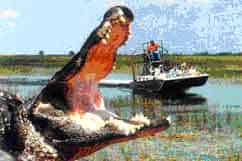
But who can afford that? Who has the time? With only a week or two available and a modest amount of cash in hand, most of us are obliged to look for places closer to home. For me, when in search of this type of time-travel, one of the most satisfying places to go is the Florida Everglades. The reasons are many and complex. First off, and of no small importance, the Everglades is easy to get to, especially for a traveler living in the eastern United States.
The park is a smooth seventy-mile drive from downtown Miami. And it is vast in size; you can get lost there. It is the second-largest national park in the Lower 48—2,200 square miles, and area approximately the size of Delaware. And despite its proximity to one of the most densely populated regions of America, it is, for its size, one of the least-visited parks in the system, especially from April to November, so you can be alone there, or nearly so.
But more to the point, every time I climb into my time machine (usually an air-conditioned rental car picked up at the Miami International Airport) and travel into the Everglades, I journey to a place that has a shivering personal resonance for me. I almost always go by myself. It’s less distracting that way, and I don’t want to be distracted, because, once there, my imagination is instantly touched at its center and all the world seems significant and personalized, as in a powerful dream. It’s my dreamtime, and I don’t want anyone, even someone I love and trust, to wake me.
Most people, if they’re lucky, have a place or two where this happens, but for me it occurs in the Everglades. Who knows why? Childhood visions of pre-Columbian Florida and the Caribbean, maybe, induced by hagiographic stories of Columbus, DeSoto, and that master of time-travelers, Ponce de León, in which I helplessly identified with the wide-eyed European explorers. Followed years later by adolescent pilgrimages to the Keys in naïve search of Ernest Hemingway’s source of inspiration—as vain an enterprise as Ponce’s, of course, but who knew that then?
And then, over the years, repeated visits to the Glades, by accidental or casual circumstances, building up a patina of personal associations, until now I always enter the park with an expectance based on nostalgia for a lost self—nostalgia for the New England boy reading about the Arawak and Columbus, for the youth trying to become a novelist, for the reckless young man footloose in South Florida.
And it’s an expectancy that is almost always met. I park my time machine and walk out onto the Anhinga or the Gumbo Limbo trail, step by step moving along on the catwalk of my own personal time line. I keep going back, and with increasing clarity, I see more of the place and more of my past selves. And more of the past of the planet as well.
Beyond any other national park, perhaps, the Everglades bears repeated visits, justifying a traveler’s return trips, but maybe requiring them too. Without intending it, over the years I’ve acquired from these visits a gradual accumulation of information—about my layered self, I suppose, and, more important, about the place—which has helped me learn to look at the Everglades and see it for what it is instead of for what it isn’t.
The first few times I didn’t get it. There are no high mountains, no rushing cataracts, no grand panoramic vistas. There’s no rain forest, no powerful continent-draining rivers, no rocky seashore. No, the Glades is quiet and low and slow, a shallow, almost invisible river of grass, an intricate, extremely fragile subtropical ecosystem that seems shy and difficult of access to the human eye, which is, of course, one of the reasons humans have come so close to destroying it—and may yet succeed.
To see the Everglades for what it is and not what it isn’t, however, you have to develop a kind of bifocal vision, as if you were floating down the Mississippi on a raft with Huck Finn. You have to learn to switch your gaze constantly from the concrete to the abstract, from the nearby riverbank to the distant sky. You need an almost Thoreauvian eye for detail and the interrelatedness of nature’s minutiae, for it is a 1.5-million-acre Walden Pond we’re talking about here, the largest wetland in the United States. From November through May there are between fifty thousand and a hundred thousand wading birds in the Everglades.
More than one hundred species of butterflies have been identified in the park. Fifty species of reptiles, including twenty-six species of snakes and sixteen of turtles. Eighteen species of amphibians. Three hundred forty-seven species of birds. Forty species of mammals. More than one thousand species of plants. There are fifty-two varieties of the live oaks along the short Gumbo Limbo Trail, where, as you stroll, you can catch the skunklike smell of white stopper buds opening, used in ancient times by the Arawak and the first white settlers as a specific against dysentery.
Gumbo Limbo Trail
The Gumbo Limbo Trail winds through great twisted old live oak trees with epiphytes and bromeliads clinging to the trunks and upper branches and dead-looking brown resurrection ferns at the roots that burst greenly into life after a rain. The trail is circular and begins and ends at the hundred-foot-tall royal palms of Paradise Key. The key is a hammock, a gentle, almost imperceptible rise in the blond, watery plain, more like a solidified limestone sea swell than an actual key or island.
The majestic palms, which these days tower photogenically in front of Miami hotels and cluster around the old Bebe Rebozo compound of Key Biscayne and a thousand other estates, appeared first on the continent here in the Everglades, their seed carried by wind and water from the Caribbean thousands of years ago to catch and eventually prosper on this very hammock.
A short way off the trail, I notice a small, still pool of water covered with bright green slime—duckweed—which, seen up close, turns into a glistening skin, as clean and beautiful and serene as snakeskin over the dark, turbulent, fecund water below. I lean down and look closer and imagine I can see into the thrashing molecular soup of life itself.
But the swarming details of the Everglades can overwhelm you. It’s almost too much to absorb and organize. In this finely delineated and particularized landscape, to gain perspective you have to step away from time to time and abstract it. Thus, along with Thoreau’s eye, you need to develop an almost Melvillean appreciation for the vast circular canopy of blue that stretches unbroken from horizon to horizon and the broad watery swale under your feet. It’s as if you are at sea and are standing upon a shimmering grassy plain that floats like the Sargasso between the firmament above and the firmament below.
The light is spectacular and shifts constantly, as clouds build and dissipate and build again. But the intensity of the light and its movement are dizzying. And to steady yourself, you shift your gaze almost involuntarily back to what’s close at hand, clinging to it as if to the rail of a ship. In so abstract a landscape, to ground yourself you have to look again at the details.
And so it goes—back and forth, the long view and the short, the abstract and the concrete—for here you are situated in an infinitely complex world whose parts, and the tissue of connections between them, can be seen only if the viewer keeps shifting his focal point. By comparison, the city of man, from nearby Miami to distant Calcutta, seems stilled, frozen, caught in a snapshot in relatively recent time, and serving either as all foreground or all background, with no movement between them.
The central figure, the subject, is always us; humanity is the figure and the ground; we are content as well as context. In the Everglades, the central figure is the ancient planet itself and its immense plenitude.
Following the Old Tamiami Trail
Sometimes, instead of visiting the southern end of the Everglades, I drive out from Miami along Route 41, the old Tamiami Trail, cross through the Miccosukee Indian Reservation, pass the airboat rentals (banned inside the park but ready to rent but ready to rent all around it) and the solitary fishermen sitting by the canals built by the Army Corps of Engineers, to reach the north side of the park and spend the day at Shark Valley.
It’s less a valley than a broad, shallow slough twelve miles wide, a one-to-three-foot-deep scimitar-shaped depression in the limestone bedrock that carries the overflow from Lake Okeechobee in a tectonically slow drift south and west at barely one hundred feet per day, sliding the fresh, nutrient-rich waters across the saw grass plain to the mangrove estuaries of the Gulf of Mexico. Out here, South Florida seems freshly emerged from the ocean, still dripping and draining back into the Gulf, as if the Ice Age had ended only yesterday. Its highest point is barely eight feet above sea level, but from it you can see for miles.
At the Shark Valley Visitors Center there’s an open rubber-tired team that carts tourists into the Glades a ways, with a Park Service guide on a loudspeaker who’ll describe what you’re seeing. But there’s also a bike-rental shop and a fifteen-mile bike path to an observation tower and numerous trails where you can walk in silence. In a half hour, I’m under the hot May sun a few miles out on the bicycle path, pedaling a wobbly old one-speed bike I rented next to the visitors center. I’m finally far enough into the Glades that I can no longer hear the visitors or their cars and RVs or the guide on the tram, so I pull off the path and stop.
Purple pickerelweed is flowering everywhere, and bladderwort, like yellow stars, blooms against the dark water of the slough. Deerflies cruise by and then swerve hungrily back toward me, a new warm-blooded mammal, and hairless, too. All I can hear now is the sound of the links of the food chain clanking.
Herons and egrets stand knee-deep in water, waiting motionless, like the fishermen I saw earlier on the Tamiami Trail alongside the canal, and now and then I hear the splash of a gar or a bass busting into the air for a low-flying dragonfly. For a long time, without making a ripple, a six-foot alligator on the far side of the slough stalks a spindly white egret, drawing closer and closer, undetected, until suddenly there is a great, furious roil and splash of water, then feathers floating, and silence as the gator slides away.
Later, out at the observation tower, I pause halfway up and look down, and in the copse below, a rust-colored fawn with pale spots across its belly lies curled and hidden by its mother. Intent only on protecting her offspring from the huge gator snoozing n the slough fifty feet away, she obviously has not considered aerial reconnaissance, especially by a human. Down below, the fawn is as still as a statue in the cool shade of the copse, and lovely, but I feel oddly invasive for watching and quickly resume climbing to the top of the tower.
There I gaze out across the watery, veldlike plain of saw grass, where in the west I can make out a bank of cumulus clouds piling up over the Gulf near Everglades City, promising rain. For a moment I consider hurrying back to the car, but then decide no, let the rain come down. And within the hour it does, and as I walk my rented bike the eight miles back to the visitors center, I find myself feeling finally invisible, lost in time and space, afloat inside a dream of a lost and coherent world.
Crossing Shark Valley by foot in the warm torrential rain, it’s almost inconceivable somehow that my points of departure—Newark, New Jersey, and Miami, Florida—are in the same time zone as the Everglades. Not just longitudinally, as on a map, but literally, as on a calendar or a wristwatch. Here and in Newark and Miami, today’s headlines are stock quotes are the same, the historical facts still hold, and thus all three places bear, at least abstractly, the same relation to the onrushing millennium, to its ethnic cleansings, genocidal massacres, famines, global floods of refugees, children gunning each other down with automatic weapons, wanton destruction of the planet—everything that drives a modern man or woman nearly mad with grief and despair, so that finally all one wants is to get out of this time zone. “Anywhere, so long as it’s out of this world,” said Baudelaire. And here I am, out of that world. Astonishing!
Later in the day, after the rain has passed east toward Miami and the Atlantic, I drive out on Route 41 to Everglades City in the northwest corner of the Everglades, where there is another visitors center and a marina located at the entrance to the Ten Thousand Islands, a huge chain of mangrove islands that stretches about forty miles from Marco Island in the north to Pavillion Key. It was Ponce de León who guessed there were then a thousand islands, but the modern count, via satellite, is 14, 022. The number keeps changing, because most of the “islands,” even those several miles across, are built on clustered red mangroves and are constantly being broken apart and restructured by hurricanes.
Chokoloskee Bay
It’s close to five o’clock, though midafternoon bright at this time of year. The sky is washed clean of clouds, and the still surface of the cordovan-colored waters of Chokoloskee Bay is glazed with a taut silvery skin. In these calm tidal waters there is an abundance of snook, tarpon, redfish, blue crabs, and bottlenose dolphins, feeding, breeding, and being preyed upon by each other, by the thousands of cormorants, ospreys, cranes, pelicans, egrets, and ibis that flock year-round on the mangrove islets and rookeries, and by the sport and commercial fishermen from the tiny villages of Everglades City and Chokoloskee as well.
They’re not preyed upon in such numbers as to endanger them yet—except, of course, for the elusive mysterious manatee, that fifty-million-year-old watery relative to the elephant, a seagoing cow with flippers. The manatees are protected, but their death rate may exceed their birth rate: These gentle two-thousand-pound animals are being decimated and cruelly wounded by the propellers of the fishing and pleasure boats that roar up and down the waterways here. Nine out of ten of the remaining eighteen hundred manatees bear ugly prop scars on their smooth backs. But there are about 700,000 registered powerboats in Florida, and, thanks to persistent lobbying in Tallahassee by the owners, there are no speed limits in these peaceful, secluded waters.
The boats race along the thousands of interlaced channels and crisscross the myriad of unnamed bays at thirty to fifty miles an hour, chopping through anything too slow or confused by the noise to get out of the way. Generally the manatees keep to the channels among the islands, feeding on sea grass in waters so darkened by the tannin from the roots and dead leaves of the red mangrove that the animal cannot see the bottom of the boat approaching; nor can it hear the roar of the motor until the boat is nearly on top of it, and thus cannot flee in time to elude death or maiming.
There’s enough daylight left to tempt me to rent a canoe at the visitors center, and I push out into the Chokoloskee Gay and paddle slowly along one of the scores of channels that cut into and around Sandfly Island in the general direction of the Turner River Canoe Trail, the start of the Wilderness Waterway that winds for ninety-nine miles through the most extensive mangrove forest in America, all the way to Flamingo and Florida Bay in the south. All I want today, however, is a few hours of solitude on the water, a closer look than was available onshore at the cormorants and frigate birds and the tricolor Louisiana heron I glimpsed heading low over the bay toward Sandfly Island.
Halfway out, barely a quarter mile from shore, a pod of bottlenose dolphins, maybe four or five, swimming a short way off my bow, notice the canoe and slice through the water to investigate, their dorsal fins racing toward me like black knife blades. After circling the intruder several times, they move off again, apparently satisfied or bored, but the last in the pod—and adolescent probably—makes a show-off’s grinning leap. It practically stands on the water and plops over, splashing me and rocking the canoe, and then cruises back to join the others.
I move out into the bay another half mile and notice that atop many of the channel markers, ospreys have built their nests, turning the poles into tall, branchless trees. They are incredibly stable birds, mating for life (fifteen to twenty years), and they use the same nest year after year. Off to my right a ways, one of the smaller islands has been converted into a rookery by a huge flock of fork-tailed frigate birds. There seems to be a great flurry of activity, so I paddle over. Fifty or more parent frigate birds are huddling protectively over their fuzzy gray hatchlings, while another fifty make a great racket and fight off dozens of predatory, sharp-beaked cormorants screeching and hungrily diving for the offspring. I draw near in my canoe and watch the fight for a long while, and invisible witness to a savage siege and great acts of parental courage and sacrifice.
On the Same Plane
To see what’s there, most national parks get you up high on a mountain or make you gape into a canyon or a gorge, playing with scale and fostering delusions of human grandeur without your even having to leave your car. “This car climbed Pikes Peak, Whiteface Mountain, Mount Washington,” and so on. In the Everglades, though, you’re kept on the same plane as the natural world. You can’t see the Everglades at all, really, unless you get close up and keep it at eye level, which humbles you a bit. (“This car drove through the Everglades” is not much of a claim.) This sort of viewing is interactive, and your travel backward in time to the continent’s beginnings is all the more convincing for it.
That’s especially true for us Americans—we whose present is too much with us, whose future looks worse, and whose past is increasingly paved over or deliberately erased—that, for our emotional and intellectual well-being, for our moral health as well, time-travel has become more essential than ever. Maybe it’s this need that explains the growing popularity and proliferation of historical theme parks, the desire to build a Disney World near a Civil War battlefield, for instance, or the whole Jurassic Park concept, which surely, as much as the animated dinosaurs, accounts for the extraordinary popularity of the movie.
It’s the idea of safe passage to the distant past that appeals. (One wonders, is that what’s behind the success of The Flinstones?) This idea may also account for the rapidly increasing popularity of our national parks. The total number of visitors is up ten percent overall in the last decade, and it’s much greater in some parks (seventy percent in Yosemite, for instance), bringing, especially in those located within easy striking distance of urban areas, traffic jams, environmental damage, graffiti, crime—all the woes of life in the here and now that we’re trying to escape.
The Everglades, which in an odd way is more demanding of its visitors’ imaginations than most other parks, has not yet suffered as they have. The greatest danger to the Glades comes from outside the park, from the agriculture industry and real estate developers who for generations have been blocking and draining off its freshwater sources in central and southeastern Florida for human use and polluting the rest with chemical fertilizers and runoff. In recent years, the National Park Service, the state of Florida, and the U.S. Army Corps of Engineers have begun cooperating to restore the old flow of water from Okeechobee as much as possible and to control with great rigor the amount of pollution allowed to enter the system.
The sky in the west faded to pale rose. Ragged silver-blue strips of cloud along the horizon glow red at the edges, as if about to burst into flame. I turn my canoe back toward the marina and am paddling fairly energetically now, for I don’t want to get caught out here after dark amount ten thousand islands and ten million mosquitoes. You could easily get lost in this maze of channels and not be found for days and be extremely ill by then. I’m reluctant to leave this primeval world, however. Once again, the peaceful, impersonal beauty of the Everglades has soothed and nourished my mind and heart and has restored some of the broken connections to my layered selves and memories. It’s time, however, to return to the city of man.
Then suddenly, a few yards ahead of my canoe, I see a swelling disturbance in the water. It smooths and rises, and the water parts and spills, as first one, then two large, sleek-blacked, pale gray manatees surface and exhale gusts of mist into the air. They slowly roll and dive, but a second later they reappear, and this time there is a calf the size of a dolphin nestled safely between them. I can hear the three animals inhaling huge quantities of air, and then they dive again and are gone. The water seethes and settles and is still. A low-flying pelican cruises down the channel ahead of me and disappears in the dusk.
For a long time I sit there in my canoe, thrilled by the memory of the sight, feeling unexpectedly, undeservedly blessed. Jurassic Park, indeed. This is the real thing! For a few wondrous seconds, a creature from the Paleocene has let me enter its world and has come close enough almost to touch. It’s as if the old planet earth itself contained a virtue, a profound generosity of spirit, that has allowed it to reach forward in time all the way to the end of the twentieth century in North America and has brought me into its embrace.
Buy This Book From Amazon The Conde Nast Traveler Book of Unforgettable Journeys: Great Writers on Great Places
- Valentine’s Day Suggestions…for that Special Person - January 22, 2026
- Missouri Sports Travel Adventure: From Landmarks to Ballparks - January 21, 2026
- What First-Time Visitors Get Wrong About Visiting Iceland - January 15, 2026


